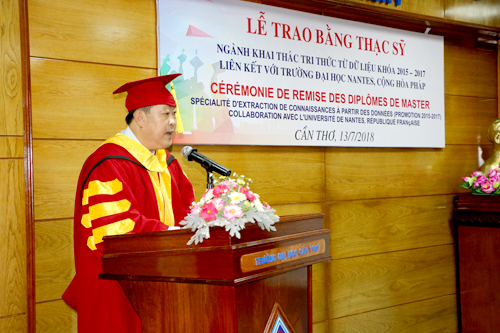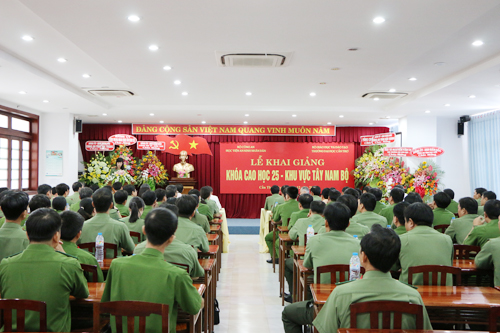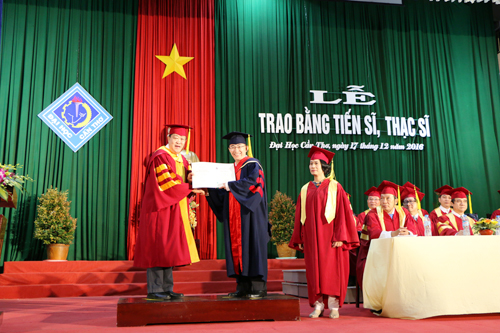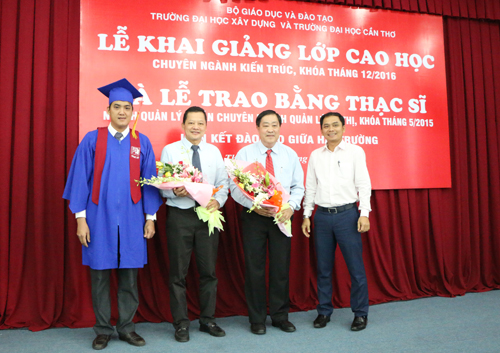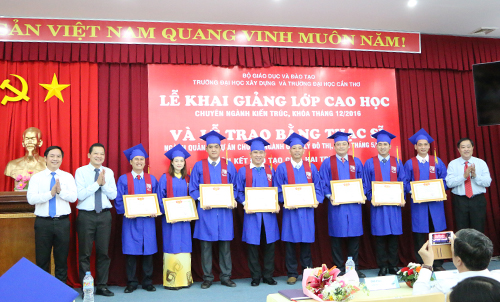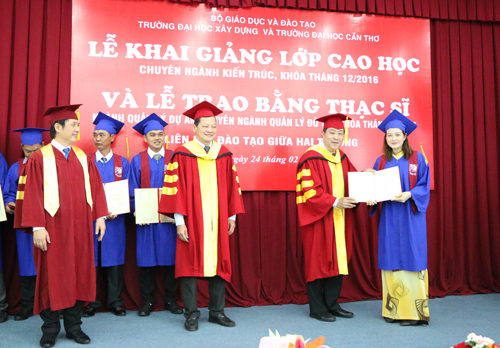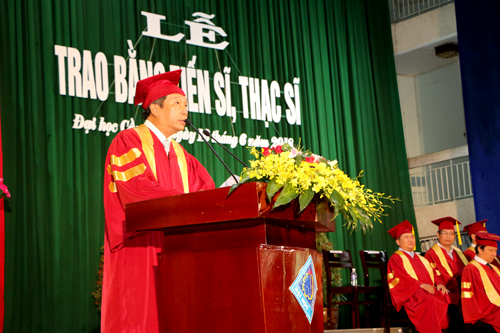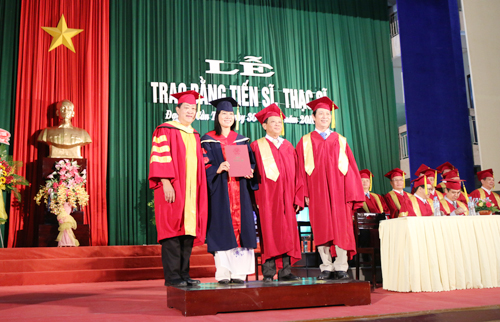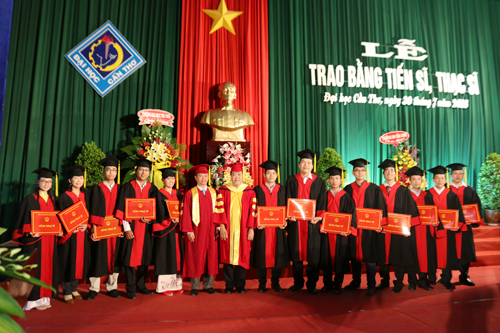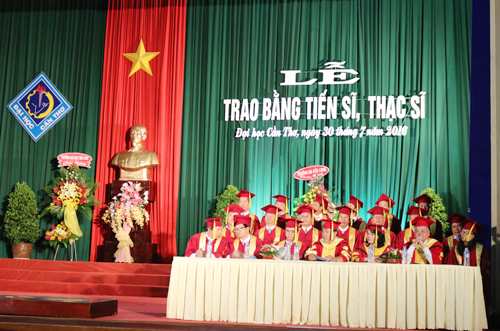 Tên đề tài: “Lợi thế so sánh trong sản xuất lúa ở đồng bằng sông Cửu Long” .
Tên đề tài: “Lợi thế so sánh trong sản xuất lúa ở đồng bằng sông Cửu Long” .
 Tác giả: Võ Minh Sang, Khóa 2012 đợt 1.
Tác giả: Võ Minh Sang, Khóa 2012 đợt 1.
 Chuyên ngành: Kinh tế nông nghiệp; Mã số: 62620115. Nhóm ngành: Nông - Lâm - Ngư nghiệp.
Chuyên ngành: Kinh tế nông nghiệp; Mã số: 62620115. Nhóm ngành: Nông - Lâm - Ngư nghiệp.
 Người hướng dẫn chính: PGS.TS. Đỗ Văn Xê, Trường Đại học Cần Thơ.
Người hướng dẫn chính: PGS.TS. Đỗ Văn Xê, Trường Đại học Cần Thơ.
- Tóm tắt nội dung luận án
Luận án: “Lợi thế so sánh trong sản xuất lúa ở đồng bằng sông Cửu Long” được đề xuất thực hiện nhằm phân tích thực trạng lợi thế so sánh trong sản xuất lúa ở đồng bằng sông Cửu Long (ĐBSCL), qua đó đề xuất các giải pháp nâng cao lợi thế so sánh trong sản xuất – xuất khẩu gạo cho đồng bằng sông Cửu Long, giúp nâng cao hiệu quả sử dụng tài nguyên quốc gia trong sản xuất lúa gạo xuất khẩu. Luận án nghiên cứu về lợi thế so sánh trên cơ sở lý thuyết chi phí nội nguồn (DRC) của Bruno (1972) và lý thuyết về chỉ số lợi thế so sánh hiện hữu (DRC) của Balassa (1965), lý thuyết hiệu quả sản xuất của M.J. Farell (1957), Charnes et al. (1978) và Banker et al. (1984). Dữ liệu sơ cấp phục vụ cho nghiên cứu của luận án được thu thập từ 668 nông hộ ở 22 huyện của 6/13 tỉnh, thành ở vùng ĐBSCL là An Giang, Đồng Tháp, Cần Thơ, Hậu Giang, Sóc Trăng và Kiên Giang. Dữ liệu thứ cấp liên quan đến chi phí gia tăng sau thu hoạch lúa đến gạo xuất khẩu từ các đối tượng như thương lái, đơn vị xay xát – chế biến – xuất khẩu được tổng hợp từ các nghiên cứu có liên quan đã công bố.
- Những kết quả mới luận án
- Nông hộ sản xuất lúa ở ĐBSCL trong mẫu nghiên cứu có quy mô diện tích gieo trồng ở mức khá lớn, hợp tác trong sản xuất có tăng, nhưng chiếm tỷ lệ còn thấp, ngoài hình thức tham gia vào hợp tác xã, có thêm hình thức hợp tác mới là tham gia cánh đồng lớn. Nông hộ có nhiều năm kinh nghiệm sản xuất, vai trò của lao động trong sản xuất chiếm phần lớn, kỹ thuật tiến bộ áp dụng trong sản xuất tăng ở mức khá. Cơ giới hóa trong sản xuất ngày càng được đẩy mạnh. Giống lúa phẩm cấp trung bình, thấp chiếm tỷ lệ cao trong canh tác. Đánh giá chung, trình độ sản xuất lúa của nông hộ khá cao, đã chủ động về giống, kỹ thuật, kiểm soát tốt mùa vụ, dịch bệnh. Nhiều giống mới, kỹ thuật tiến bộ được thử nghiệm, áp dụng vào sản xuất. Kinh nghiệm, kỹ thuật, trình độ và năng lực sản xuất lúa của nông hộ khá tốt và khá tương đồng giữa các khu vực nghiên cứu.
- Hiệu quả trong sản xuất lúa của nông hộ ở ĐBSCL được đánh giá qua các tiêu chí là hiệu quả năng suất và chi phí, kết quả phân tích ghi nhận: (1) Năng suất sản xuất lúa của nông hộ ở mức cao và khá đồng đều giữa các khu vực sản xuất, nhưng hiệu quả năng suất ở mức trung bình khá và (2) Hiệu quả chi phí trong sản xuất lúa mức trung bình khá. Đánh giá chung, năng suất sản xuất và chi phí sản xuất ở mức cao. Phần lớn, nông hộ chưa đạt tối ưu về quy mô sản xuất, đa số nông hộ thâm dụng quá mức yếu tố sản xuất. Nông hộ cần giảm liều lượng sản xuất để nâng cao hiệu quả trong sản xuất lúa.
- Từ năm 2009-2011, ĐBSCL có lợi thế so sánh trong sản xuất – xuất khẩu gạo, có lợi thế về chi phí nội nguồn và năng lực, lợi thế cạnh tranh trong xuất khẩu gạo. Trong giai đoạn này, giá trị ròng thu được từ xuất khẩu gạo nhiều hơn hơn chi phí nội nguồn sản xuất, có đóng góp cho xã hội. Nhưng từ năm 2012-2015, lợi thế so sánh trong xuất khẩu gạo của ĐBSCL đã không còn, chi phí nội nguồn phải huy động để phục vụ cho sản xuất – xuất khẩu gạo nhiều hơn so với giá trị ròng thu được từ xuất khẩu gạo, ích lợi xã hội bị tổn thất và năng lực, lợi thế cạnh tranh trong xuất khẩu gạo cũng giảm mạnh. Nguyên nhân chính làm mất lợi thế so sánh trong sản xuất - xuất khẩu gạo từ năm 2012-2015 do: (1) Thâm dụng quá mức lợi thế sản xuất (thâm dụng quá mức yếu tố sản xuất dồi dào), dẫn đến “lạm phát cung: thừa sản lượng, giảm giá trị” nên tác động giảm giá xuất khẩu, trong khi đó chi phí tăng và (2) Thiếu/đầu tư không hiệu quả vào lợi thế cạnh tranh, nên lợi thế cạnh tranh thấp và giảm theo thời gian.
- Kết quả nghiên cứu ghi nhận các nhân tố nhân tố tác động đến lợi thế so sánh gồm: (1) Lợi thế sản xuất, (2) Lợi thế cơ giới hóa và (3) Lợi thế cạnh tranh. Trong đó, lợi thế cạnh tranh có tác động mạnh nhất đến lợi thế so sánh trong sản xuất – xuất khẩu gạo ở ĐBSCL. Lợi thế trong sản xuất là do lợi thế về tự nhiên, lợi thế tay nghề và lợi thế cơ giới hóa. Còn với lợi thế cạnh tranh trong xuất khẩu gạo của Việt Nam hiện đang ở mức thấp (từ năm 2012-2015) và chủ yếu nhờ vào lợi thế giá thấp, giảm theo thời gian.
- Để khôi phục và gia tăng lợi thế so sánh trong sản xuất – xuất khẩu ở ĐBSCL cho thời gian tới cần tăng được giá xuất khẩu, giảm chi phí sản xuất – xuất khẩu và nâng cao giá trị thương hiệu gạo Việt. Các giải pháp được đề xuất là: (1) Giải pháp tiêu thụ, tập trung xác lập thị trường mục tiêu, chiến lược thương hiệu, chiến lược cạnh tranh và chiến lược tiêu thụ và (1) Giải pháp sản xuất, tập trung hoạch định lại chiến lược và chính sách sản xuất - xuất khẩu gạo, quy hoạch sản xuất lúa gạo, giảm chi phí sản xuất và tăng cường áp dụng khoa học kỹ thuật tiến bộ, cơ giới hóa trong sản xuất - chế biến cho đến năm 2020 và tầm nhìn đến năm 2030.
Từ kết quả nghiên cứu đã đúc kết 8 vấn đề về mặt khoa học liên quan đến lý thuyết lợi thế so sánh: (1) Đánh giá lợi thế so sánh cần được tiến hành đánh giá trên lợi thế trong sản xuất và lợi thế trong tiêu thụ; (2) Lợi thế so sánh cần được đánh giá trong môi trường cạnh tranh; (3) Xác lập mối tương quan dương giữa hiệu quả sản xuất và lợi thế so sánh; (4) Bổ sung thêm lợi thế cạnh tranh vào nhân tố tác động đến lợi thế so sánh bên cạnh nhân tố lợi thế sản xuất; (5) Liên tục thâm dụng quá mức lợi thế sản xuất sẽ góp phần làm giảm lợi thế so sánh: (6) Lợi thế trong sản xuất mang tính tĩnh và giảm theo thời gian, cần tăng cường đầu tư gia tăng lợi thế động như: lợi thế tiêu thụ, lợi thế cạnh tranh, nếu đầu tư tốt sẽ gia tăng theo thời gian; (7) Thị trường là khởi nguồn cho định hướng hoạt động sản xuất và (8) Khi sản xuất đạt đến quy mô lớn và ổn định để xác định hiệu quả và lợi thế so sánh cần phân tích mang tính hệ thống và toàn diện từ sản xuất đến tiêu thụ.
- Các ứng dụng trong thực tiễn, các vấn đề cần tiếp tục nghiên cứu:
- Kết quả nghiên cứu lợi thế so sánh trong sản xuất lúa ở đồng bằng sông Cửu Long đã phân tích thực trạng lợi thế so sánh trong sản xuất lúa cùng với những nguyên nhân, nhân tố tác động đến lợi thế so sánh trong thời gian qua. Những giải pháp nâng cao lợi thế so sánh trong sản xuất – xuất khẩu gạo cho ĐBSCL sẽ là tài liệu quan trọng để nhà nước và các ban ngành tham khảo khi hoạch định chiến lược và chính sách phát triển liên quan đến ngành hàng lúa gạo của ở ĐBSCL.
- Luận án là tài liệu tham khảo hữu ích phục vụ cho quá trình đào tạo các chuyên ngành Kinh tế nông nghiệp và Phát triển nông thôn ở bậc đại học và sau đại học.
3.2. Vấn đề bỏ ngỏ cần tiếp tục nghiên cứu
Trong phạm vi nghiên cứu, luận án vẫn còn một số tồn tại nhất định. Do đó, luận án gợi mở một số định hướng nghiên cứu trong thời gian sắp đến như sau: (1) Nghiên cứu về chính sách xuất – nhập khẩu của ngành hàng lúa gạo tác động đến lợi thế so sánh trong sản xuất – xuất khẩu gạo của Việt Nam, (2) Nghiên cứu các nhân tố tác động đến giá gạo xuất khẩu của Việt Nam, (3) Nghiên cứu về đổi mới công nghệ chế biến gạo xuất khẩu và (4) Nghiên cứu hiệu quả sản xuất và lợi thế so sánh đối với các sản phẩm chủ lực ở đồng bằng sông Cửu Long.
INFORMATION OF DISSERTATION
The title of dissertation: “The comparative advantage in rice production in the Mekong Delta”
Major in: Agricultural Economy Code: 62620115
PhD Candidate: Vo Minh Sang
Supervisor: Assoc. Prof. PhD. Do Van Xe
Educational Unit: Can Tho University
- Summary of the dissertation
The dissertation: “The comparative advantage in rice production in the Mekong Delta” is an execution proposal to analyze current comparative advantage in the Mekong Delta’s rice production and, consequently, to propose solutions which help enhance comparative advantage in rice production and export for the Mekong Delta, and improve efficiency of national resource usage in rice production for export. The thesis studies comparative advantage on the basis of the concept of domestic resource cost (DRC) by Bruno (1972), the theory of revealed comparative advantage (RCA) by Balassa (1965), and the measurement of productive efficiency by M.J. Farell (1957), Charnes et al. (1978) and Banker et al. (1984). Primary data for the study of this thesis was collected from 668 farm households in 22 districts in 6 of 13 provinces in the Mekong Delta, which includes An Giang, Dong Thap, Can Tho, Hau Giang, Soc Trang and Kien Giang. Secondary data related to cost increase in post-harvest to rice export from merchants and milling-processing-exporting enterprises was summarized from relevant published researches.
- The new findings of the dissertation
Farm households producing rice in the Mekong Delta in the sample have large-scale areas under cultivation. Cooperation in production increases, but makes up only a small percentage. Beside cooperatives, there is another new form of cooperation called “big field”. Farm households have many years of experience in production. Labor plays a major role in production. There is a moderate increase in the use of advanced techniques in production. Machine-based is being boosted in manufacturing. Average and low quality rice varieties make up a high percentage in cultivation. Generally, farm households have high standard in rice production and take the initiative in variety, technique, good control of crops and diseases. Many new varieties and advanced techniques have been experimented and applied to production. Experience, technique, standard and rice production competence of farm households are quite good and equivalent among the areas of research.
The efficiency in farm households’ rice production in the Mekong Delta is evaluated on the criterions of effective capacity and cost. The results acknowledge that (1) the productivity of farm households’ rice production is high and equivalent among the productive areas, though the effective capacity is only fair average, and (2) the cost efficiency in rice production is fair average. Generally, the productivity and the productive cost are high. Most farm households are not optimal in the scale of production, and overuse intensive factors of production. Farm households need to reduce production to improve efficiency in producing rice.
From 2009 to 2011, the Mekong Delta had comparative advantage in rice production and export, and gained advantages in domestic resource cost and competence, and competitive advantage in rice export. In this period, net asset gained from exporting rice was more than domestic resource cost in production, which was a societal contribution. However, from 2012 to 2015, there was no longer a comparative advantage in the Mekong Delta’s rice export. Domestic resource cost called to supply rice production and export was more than net asset gained from rice export. Societal benefits were damaged and the competence plus competitive advantage in rice export were significantly decreased. The major reasons which caused the loss of comparative advantage in rice production and export from 2012 to 2015 were: (1) a hyper-intensive use of productive advantage (a hyper-intensive use of abundant factors of production), which led to “supply inflation with redundant yields and diminished prices” and thus reduced export price, whereas costs increased, and (2) a lack of efficient investment in competitive advantage, causing it to lower and decrease gradually.
Research result recorded factors which affect comparative advantages: (1) productive advantage, (2) machines-based advantage and (3) competitive advantage. Competitive advantage is the strongest factor in rice producing – exporting in Mekong Delta. Advantages in production come from nature, experienced labors, and machine-based. Competitive advantages in rice exporting is in low level (from 2012 –2015) and almost due to low sale price, annual decrease.
To recover and enhance comparative advantage in production-export in the Mekong Delta, it is necessary to increase export price, reduce production-export costs and improve the value of Vietnamese rice brand name. The proposed solutions are (1) for consumption, which means focusing on target market establishment, brand strategies, competitive strategies and consumption strategies, and (2) for production, which focuses on reforming of strategies and rice production-export policies, planning rice production, reducing costs in production and encouraging the use of advanced science, technique, and machine-based in producing-processing until 2020 and a vision up to the year of 2030.
According to the results of the study, there are 8 scientific strategies related to the theory of comparative advantage: (1) Comparative advantage evaluation needs to be executed on advantages in production and in consumption; (2) Comparative advantage needs to be evaluated in a competitive environment; (3) Establish a plus interrelation between productivity and comparative advantage; (4) Add competitive advantage to factors affecting comparative advantage beside productive advantage; (5) Continual hyper-intensive use of productive advantage will lead to a reduction in comparative advantage; (6) Advantage in production is static and gradually decreases, so it is necessary to invest in improvement of dynamic advantages such as consumption advantage and competitive advantage, which will increase with time when having a good investment; (7) The market is the origin of manufacturing orientation and (8) When production reaches a large, stable scale to identify efficiency and comparative advantage, it is essential to analyze completely and systematically from production to consumption.
- Applications in reality and problems in need of further studies
3.1. Ability to apply in practice
The results of the study on comparative advantage in rice production in the Mekong Delta have analyzed the reality of comparative advantage in rice production, its causes and factors affecting comparative advantage so far. Solutions for improving comparative advantage in rice production-export in the Mekong Delta will be important documents for the government and other departments to refer to when forming strategies and development policies related to the rice industry in in the Mekong Delta.
The thesis is a helpful reference for the undergraduate and postgraduate training programs in Agricultural Economics and Rural Development.
3.2. Issues left open to further research
There are a few shortcomings in the thesis in terms of the study area. Therefore, the thesis has suggested a number of study orientations in the coming time: (1) Study import-export policies in the rice industry which affect comparative advantage in Vietnamese rice production-export, (2) Study some factors which affect Vietnamese rice export price, (3) Study the innovation in rice processing technology for export and (4) Study productivity and comparative advantage on the major products in the Mekong Delta.
>> Xem chi tiết nội dung luận án
>> Xem thông tin đăng tải tại Website Bộ giáo dục và Đào tạo.





